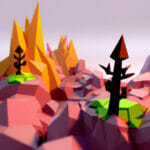Sure, here is the beginning of the article, covering the introduction and the first two sections.
If you’ve ever explored the vast, ever-changing landscapes of games like Minecraft, No Man’s Sky, or The Elder Scrolls II: Daggerfall, you’ve experienced firsthand what procedural generation can do. This powerful technique, which involves creating data algorithmically as opposed to manually, is changing the face of game development, making it possible to create larger and more varied gaming environments than ever before. In this guide, we’ll dive deep into procedural generation, exploring how it works, why it’s important, and how you can start incorporating it into your own game development projects.
Table of contents
What is procedural generation?
Procedural generation is a process that uses algorithmic methods to automatically create content. This procedure can be used in a wide variety of applications within game development, from creating textures and 3D models to generating expansive in-game environments.
The technique utilizes randomized mathematical algorithms to automatically generate data. This method ensures each creation is unique and unpredictable, a factor that can greatly enhance the gameplay experience. Not only does it allow for greater content variability, but it also significantly reduces the size of game files, as procedurally generated data only needs to store the algorithms instead of individual data points.
Why Learn Procedural Generation?
Nowadays, procedural generation is becoming a critical skill for any game developer.
- Unlimited Content: Being able to generate unique and unlimited content algorithmically gives developers the ability to create infinitely explorable game worlds like those in Minecraft and No Man’s Sky.
- Save Space: Since procedural generation only needs to store algorithms instead of numerous graphical assets, this kind of content creation leads to smaller file sizes, making games lighter and more accessible.
- Enhanced Gameplay: This technique enables unpredictable gameplay, adding an element of surprise and replayability to games that use it.
- High Demand: With the rise of procedurally generated games, the demand for developers with knowledge in procedural generation has increased in the gaming industry.
Examples of Procedural Generation in Popular Games
Procedural generation has been at the heart of some of the most popular and influential video games of the last decade. Here are a few standout examples:
- Minecraft: The entire world of Minecraft, including the landscapes, caves, and ecosystems, is procedurally generated. This makes for a different experience each time a player starts a new game.
- No Man’s Sky: This open-world adventure game features a universe with over 18 quintillion unique planets, all created through procedural generation. The fauna, flora, terrain, weather, and star constellations are all unique, making for an immersive and ever-evolving gameplay experience.
- The Binding of Isaac: This game features a dungeon crawler gameplay where the layout of the dungeons changes each time a new game is started, thanks to procedural generation. This leads to increased replayability and unpredictability.
- Rogue: One of the earliest examples of a video game utilizing procedural generation, Rogue set the precedent for this technique. Each dungeon level in the game was generated procedurally, marking a turning point in game development history.
These games underline the massive potential and versatility of procedural generation. By mastering this technique, you can enhance your games and open up a world of unlimited possibilities.
How to Get Started with Procedural Generation
Learning procedural generation might seem daunting, but it’s much more approachable when you break it down into steps. Here’s a recommended learning path:
- Master a Programming Language: Knowledge of a scripting language is essential. C# is a favored language in many game development platforms, such as Unity.
- Understand Algorithms: Grasping the basics of algorithms and how they can be used to generate game content is essential in procedural generation.
- Get Familiar with Random Number Generation: Learning how to use random number generators allows for creating varied and unpredictable outcomes.
- Start Small: Begin by generating small things like 2D terrains or tile maps before progressing onto more complex systems.
- Practice: Apply what you’ve learned in projects. There’s no better way to consolidate your knowledge than by using it in practical applications.
Even though learning a new skill can be challenging, remember that every expert was once a beginner. Remarkable games like Minecraft or No Man’s Sky were not built overnight, but step by step, one line of code at a time.
We recommend our comprehensive Unity Game Development Mini-Degree for anyone interested in mastering procedural generation. This course is designed to take you from absolute beginner to proficient developer. We’ve created this curriculum to provide you with the practical skills necessary to build your own games. In addition to procedural generation, you’ll learn useful concepts like 2D and 3D game development, NPC AI, and much more.
At Zenva, we believe in providing our learners with real-world skills they need to succeed in the ever-evolving technology landscape. Join us, and gain the confidence to create your own video games and stand out in this exciting field.
Learning Resources
In your journey to master procedural generation in game development, there are a range of resources that can provide you with the guidance and education you need. We’ve handpicked some of the best options available, focusing on comprehensive, in-depth, and beginner-friendly resources.
Unity Game Development Mini-Degree
Offered by Zenva Academy, the Unity Game Development Mini-Degree is an all-inclusive collection of courses teaching game development using Unity, one of the most widely-used game engines in the world. It covers a variety of topics including:
- Game mechanics
- Cinematic cutscenes
- Audio effects and more.
This comprehensive degree program is suitable for beginners and an effective way to gain an edge in various industry sectors.
The Complete Procedural Terrain Generation Course
The Complete Procedural Terrain Generation Course from Zenva Academy specifically focuses on terrain generation in Unity, teaching you to:
- Generate noise maps
- Apply textures to terrains
- Define specific biomes
This course is 3 hours and 34 minutes long and designed for those with a basic understanding of Unity and C#
Complete Guide to Procedural Level Generation in Unity
This tutorial on GameDev Academy provides a deep dive into Unity procedural generation for creating levels, covering:
- Generating noise
- Creating level tiles
- Assigning terrain types
The article is part of a series and includes ample code examples and visualization guidance.
The Complete 2D Roguelike Dungeons Course
The Complete 2D Roguelike Dungeons Course offered by Zenva Academy delves into the creation of a roguelike dungeon crawler game using Unity. The course explores:
- Procedural dungeon generation
- Enemy implementation
- Battle systems, and more.
This course is suitable for all learning levels, from novices to experienced individuals.
Procedural Maze Unity Tutorial
This GameDev Academy article discusses procedural maze generation using Unity and C#, introducing recursion and its application in game development. This tutorial is aimed at intermediate to advanced developers.
2D Procedural Maps for Beginners
Offered by Zenva, 2D Procedural Maps for Beginners is a course that covers how to programmatically construct 2D tilemaps based on procedural generation principles. The course covers:
- Noise maps and noise map settings to get different kinds of maps
- Working with multiple kinds of biomes for map variety
- Adding players to procedurally generated map worlds
Create Noise Maps for Procedural Generation
In this short but totally free tutorial on GameDev Academy, you’ll discover one of the key methods used for procedural generation: noise maps. You’ll come to understand why they’re crucial for creating the randomness seen in generated worlds, and also how to access that generation in Unity.
There are numerous other resources available online if you’re interested in diving deeper. Don’t hesitate to experiment and try new things – the world of procedural generation is as vast and varied as the game worlds you can create with it!
What is Procedural Generation – Wrap-Up
Procedural generation is an exciting field in game development that brings your games to life with randomness and unique content, ensuring a new experience every time your game is played. This creative technique can make your games more dynamic, interesting, and replayable, enhancing your game’s appeal and depth.
Grasping the concepts and implementing this technique might seem like an uphill task but remember, with patience, practice and the right guidance, you can master it. Taking a step forward in your learning today can put you miles ahead over time. The exciting world of procedurally generated game worlds awaits you, it’s time to dive in and start creating your own.
To arm you with the right knowledge and practical skills, we highly recommend checking out the Unity Game Development Mini-Degree from Zenva. This comprehensive course is designed for everyone, from the absolute beginner to the seasoned developer, and offers a step-by-step guide to mastering procedural generation among many other game development aspects.
Never stop growing, engaging and learning. Each new skill is a powerful addition to your arsenal as a game developer. Now is the time to take advantage of the endless opportunities that procedural generation can offer you in the gaming industry. We, at Zenva, are excited to be part of your journey in mastering procedural generation.
Did you come across any errors in this tutorial? Please let us know by completing this form and we’ll look into it!

FINAL DAYS: Unlock coding courses in Unity, Godot, Unreal, Python and more.







